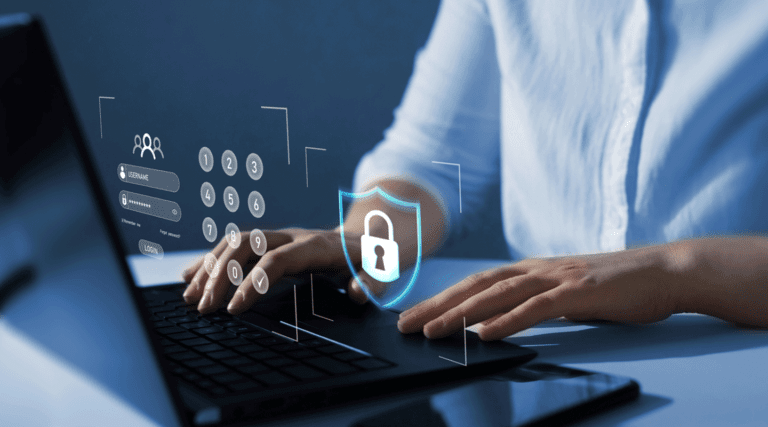A Comprehensive Approach to Data Security Management

How to fortify data collection, transmission, and storage whether in the field or in the office.
Data has become the crown jewel of most organizations. And just like the real crown jewel, it is at high risk of theft and misuse. Organizations that fail to adequately protect their data pay a high price.
Recent research from IBM reveals that the global average cost of a data breach is 4.45 million USD, an increase of 15% over the past three years. But the true costs go beyond – causing damage to a brand’s reputation, reducing consumer trust, and endangering research subjects, survey respondents, and/or clients.
When a data breach occurs, Harvard Business Review notes companies can see their credit rating downgraded and their stock price impacted. On average, companies that have experienced a significant data breach underperform the NASDAQ by 8.6% after one year, and the gap can widen to 11.9% after two years. There can be other potential serious consequences to non-governmental organizations (NGO) and nonprofit organizations, too. A data breach of the International Committee of the Red Cross in 2022 exposed the medical information of 515,000 vulnerable people.
Conversely, investing in data security and avoiding data breaches keeps people safe and can even boost the bottom line. In one IBM study, organizations with a more mature security approach and capabilities saw a 43% higher revenue growth rate over five years than their less fortified counterparts.
The message is clear: data security management must be paramount for any organization, and it must be thorough. To help you secure your data and mitigate vulnerabilities, this guide provides a comprehensive look at how to improve data security management across diverse environments and throughout every stage of the data lifecycle.
Data security risks and threats

Data can be collected and stored in a database or a device, such as a mobile phone, tablet, or laptop. However, the security threats are different and should be well understood, as most organizations collect and store data in both devices and databases.
Common risks and threats for mobile devices
Using mobile devices to collect data can increase collection efficiency and data accuracy. However, devices pose their own set of risks for data breaches. In fact, 45% of organizations report having recently experienced a mobile-related compromise.
Here are some of the most prevalent data security risks with mobile devices:
- Device theft or loss: Beyond the hassle and cost of device replacement, device theft or loss can result in lost data or unauthorized access to sensitive data harbored within the device.
- Physical access to devices: When devices are left accessible, individuals can bypass weak security measures and gain unrestricted access to a device’s data.
- Malware and malicious apps: Malware and malicious apps, once installed, can clandestinely siphon sensitive information, track user activities, or even grant unauthorized access to a device. And the threat is more common than many think: 46% of organizations say that apps have contributed to mobile-related security breaches.
- Unsecured Wi-Fi networks: Unsecured Wi-Fi networks lack encryption, which allows cybercriminals to intercept data transmissions and potentially maliciously use that data.
- Insufficient update and patching: Devices may not get patched or updated regularly by users, which leaves the devices open to known vulnerabilities.
Common risks and threats for databases
From potential data breaches due to bad actors outside the organization to insider threats, databases have several security vulnerabilities that require additional security measures.
Here are the most common threats to consider:
- Data breaches: A data breach can occur due to vulnerabilities in security systems or malicious attacks, potentially leading to severe consequences for organizations, such as financial losses, damage to reputation, and legal ramifications.
- Inadequate access controls: When there is insufficient restriction on access levels to stored data, it can lead to unauthorized modification, extraction, or deletion of critical or sensitive data within the database.
- Data corruption and loss: Technical glitches, hardware failures, or cyberattacks can lead to the degradation or complete loss of vital information within the database.
- Insider threats: Insider threats arise from individuals with authorized access who misuse their privileges. This can include intentional or accidental actions that compromise data security, such as leaking sensitive information or intentionally causing damage to the database. Insider threats are particularly challenging to detect and mitigate in database environments, necessitating vigilant monitoring and well-defined access controls.
Layers of security to prevent unauthorized access
Having multiple layers of security helps establish a multi-tiered defense against unauthorized access to your data and can significantly reduce the likelihood of unauthorized entry. These layers encompass various security measures – from device-level protections to robust transmission and storage protection.
Device-level security considerations
There are several layers of security that can be applied at the device level to protect sensitive data. These include:
- Device locking: Implementing strong passwords, PINs, or pattern locks helps secure the device from unauthorized access and acts as the first line of defense.
- Biometric authentication: Using biometric features like fingerprint recognition or facial scans adds an extra layer of security whereby only authorized individuals with these unique biological identifiers can access the device.
- Two-factor authentication: Requiring a second form of authentication, such as a password and a verification code sent to a trusted device, provides an additional barrier against unauthorized access.
- Remote tracking and wiping: Enabling features that allow remote tracking and wiping of a device in case of loss or theft helps to locate the device and ensures that even if the physical device is compromised, the data can be erased to prevent unauthorized access.
- Automatic locking: Configuring devices to automatically lock after a period of inactivity provides an additional layer of security, especially in shared or public environments.
- Device encryption: Employing encryption techniques ensures that the data stored on the device is encoded and can only be decrypted with the correct key. This protects against unauthorized access even if the physical device is compromised.
- App permissions: Regularly reviewing and managing app permissions ensures that only necessary and trusted applications have access to sensitive data.
- Guest mode or restricted profiles: Some devices offer the option to set up guest accounts or restricted profiles with limited access to sensitive data. This can be especially prudent if the device is shared with others.
- Secure boot and firmware updates: Ensuring that the device’s firmware and operating system are up-to-date with the latest security patches and updates will help protect against known vulnerabilities.
- Disable USB debugging: For Android devices, turning off USB debugging prevents potential unauthorized access via USB connections.
Data security at rest and in transmission
Data at rest is in a static state, stored on a physical device, server, or database. Data in transmission is data that is traveling across networks or communication channels. Encryption should be a key strategy, whether protecting data at rest or in transmission.
How encryption offers strong data security
Encryption converts data into a code or cipher to secure it from unauthorized access during storage or transmission. It ensures that even if data is intercepted or accessed by unauthorized parties, it remains unintelligible without the correct decryption key.
Encryption safeguards against many of the threats to data security, including data breaches, unauthorized access, and tampering. The technology is essential to maintaining confidentiality, integrity, and data privacy.
When implementing encryption, there are three key areas to consider:
- Encryption key management: Effective encryption requires careful management of cryptographic keys, including generating, distributing, storing, and periodically updating encryption keys to maintain the security of encrypted data.
- Application-level encryption: By integrating encryption directly into software applications, you can ensure the data is encrypted before it reaches storage or transmission, adding an extra layer of security beyond standard encryption best practices.
- Database encryption: By encrypting data at the storage level within a database system, you can provide a critical defense against insider threats and unauthorized access to sensitive data. With database encryption, even if an attacker gains unauthorized access to the database files, they won’t be able to decipher the information without the correct decryption key.
End-to-end encryption as a primary security layer
End-to-end encryption employs a series of cryptographic processes to secure data communication. It begins with the generation of cryptographic keys. The data is encrypted using the recipient’s public key, which allows only the recipient with the corresponding private key to decrypt and access the information. When transmitting data across the network, it remains unintelligible without the private key, even if intercepted, because the data was encrypted before transmission. Once the encrypted data reaches the recipient, the data is decrypted using the private key, and the data becomes accessible in its original form.
By encrypting data at its source and decrypting it only at its destination, end-to-end encryption minimizes the risk of interception or tampering at every stage. This helps maintain data confidentiality and minimizes intermediary vulnerabilities, such as the risk of interception or tampering. It also protects from third-party access, like third-party service providers or intermediaries, while maintaining data integrity and authenticity by guaranteeing the data remains unaltered during transmission.
With cloud-based solutions for data management becoming extremely popular, it’s important to consider that while access to the data may be very convenient and seamless, these systems almost never provide end-to-end encryption, exposing your data to access by third-party service providers. While the downside of end-to-end encryption is that it can create more friction in the user experience than cloud-based access to data, the trick is to find applications that provide end-to-end encryption but have also given thought as to how to make the user experience as easy and similar to a cloud-based experience without sacrificing data security.
Best Practices for data security and compliance

Implementing best practices for data security management serves as the bedrock of a resilient and trustworthy digital landscape. Here are the top best practices that will help your organization maintain a strong data security posture regardless of the means of data collection, storage, or transmission.
Adhere to industry standards
Industry-specific regulations and standards, such as SOC2, GDPR, and HIPAA, are designed with data security in mind. These frameworks provide guidelines and requirements that establish a strong foundation for robust data protection measures. When selecting data collection and management tools or databases, knowing that the platform or service adheres to these types of industry standards – even if you don’t need them for compliance within your organization – helps you to further validate that the solution you’ve selected takes data security seriously and has processes in place to manage and audit its security measures.
Use role-based access controls
Creating user roles with various levels of access to your data will help limit the exposure of data. You can segment access by categorizing users into specific groups or roles, each with distinct access levels. Applying the “least privilege principle,” which restricts users’ access to the minimum level necessary to perform their job functions further reduces the potential for security breaches.
Educate users on best security practices
Providing comprehensive training to users on security protocols, potential threats, and safe practices is essential to strong data security management. Not only are educated users more vigilant, but they are also less likely to fall victim to common security pitfalls. Yet, 44% of companies don’t give employees security training on a regular basis.
Technical documentation from vendors can also be used to help educate users by making sure they have the resources to effectively implement data security best practices such as password management and secure communication.
Regular auditing and monitoring
Implementing continuous monitoring practices provides a proactive approach to data security management that allows organizations to detect and respond to potential security breaches in real-time. The establishment of a regularly occurring risk assessment committee, which meets monthly or quarterly, can help to proactively monitor and assess potential vulnerabilities and examine emerging threats. Continuous monitoring can also include the use of tools and processes that allow for the regular monitoring of user access permissions and authentication protocols. For example, if an employee attempts to access sensitive data outside of their usual work hours or from an unusual location, the system can generate an alert for further investigation.
Likewise, conducting regular, thorough audits of systems, processes, and access logs is crucial for evaluating compliance with data security policies. A comprehensive data security audit typically involves a multi-faceted approach. Many organizations opt for an annual audit as a baseline, with more frequent reviews (such as quarterly or semi-annual) for industries with heightened security concerns, like finance or healthcare.
To ensure impartiality and objectivity, it is advisable to hire an independent third-party auditor, separate from the internal team responsible for day-to-day security operations. This external auditor brings an unbiased perspective and is less likely to overlook internal blind spots.
A typical data security checklist includes the following components:
- Policy and procedure review: Examine existing policies and procedures related to data security, such as access control policies, encryption protocols, incident response plans, and any other relevant documentation.
- Access control assessment: Evaluate user access permissions and ensure they align with established policies. Verify that only authorized personnel have access to sensitive information.
- Software and patch management: Confirm that all software, including operating systems, applications, and security tools are up to date with the latest patches and updates. Identify any gaps in this process.
- Network security examination: Analyze your organization’s network infrastructure for vulnerabilities, including firewall configurations, intrusion detection/prevention systems, and any other security measures in place.
- Physical security checks: Inspect physical access points to sensitive data, such as server rooms or data centers to ensure they are adequately protected.
- Incident response plan testing: Validate the effectiveness of the organization’s incident response plan by simulating potential security incidents and evaluating the response process.
- Data encryption verification: Confirm that data, both in transit and at rest, is appropriately encrypted to safeguard against unauthorized access.
- Data backup and recovery assessment: Ensure that robust backup and recovery procedures are in place to safeguard against data loss in the event of a security breach.
- Employee training and awareness: Evaluate the effectiveness of training programs to ensure employees are well-informed about data security best practices and potential threats.
- Vendor and third-party risk management: Assess the security measures of vendors and third-party partners that have access to sensitive data or systems.
- Regulatory compliance review: Confirm adherence to relevant data protection laws and industry-specific compliance requirements.
Lean on vendor support and resources to ensure security
Collaborating with trusted vendors and leveraging their expertise and resources can provide valuable insights and tools to enhance security measures. Vendors often have specialized knowledge in their respective domains and can offer additional solutions and best practices to fortify data protection.
Balance security with user-friendliness to avoid circumvention
Striking a balance between robust security measures and user-friendliness is essential. If security measures are overly complex or restrictive, users may attempt to bypass them, inadvertently creating vulnerabilities. Ensuring that security protocols are intuitive and manageable helps maintain compliance and protects against potential breaches.
Balancing data collection and user privacy

Striking the right balance between collecting essential data and safeguarding user privacy is essential, but can be challenging. Here’s a look at how companies can best achieve the right balance:
Make end-to-end encryption easy for the end user
While end-to-end encryption plays a pivotal role in safeguarding user privacy, it must also ensure a seamless and effortless experience for the end user. Therefore, when seeking out data technologies and applications, it’s important to evaluate how well the technologies implement end-to-end encryption in a user-friendly way. Typically, this involves systems and applications designed to handle encryption in the background, which requires minimal user intervention. Applications and technologies that automate the encryption and decryption processes further enables users to enjoy the benefits of heightened data security without needing to grapple with intricate cryptographic procedures.
Collect only necessary data
Collecting data should be a purposeful endeavor where every piece of information gathered serves a defined and legitimate objective. For example, if you’re developing a survey, think carefully about what questions you do and don’t need respondents to answer. Since questions about addresses, contact information, household size, number and ages of children, etc. are considered sensitive data, be sure to only ask questions that are directly relevant to your project’s goals. Justifying the necessity of data collection not only enhances transparency but also ensures that user privacy is respected. This approach fosters a sense of trust between users and the entity collecting their data.
Masking sensitive information for different use cases
Masking sensitive data through selective disclosure, which reveals only specific pieces of information relevant to a given transaction or interaction and through a need-to-know basis, ensures the protection of confidential information while still allowing for necessary operations. For example, when processing payments or conducting financial audits, sensitive details like credit card numbers or personal identification should be masked to prevent unauthorized access or potential fraud. Another use case is healthcare data, where patient records contain sensitive medical information. By masking certain elements, such as social security numbers or specific diagnoses, patient privacy is preserved while enabling essential medical care.
When designing data collection forms and systems, it is also important to consider how you will expose the information in subsequent use cases. For example, if you collect Social Security numbers, but customer representatives don’t need access to this information, you can design it so that the representative only sees the last four digits, not the whole number.
Data retention policies
Data retention policies set explicit guidelines on how long various types of data can be retained. Automated deletion processes can be integrated into data retention policies to increase efficiency and consistently manage data throughout its lifecycle, reducing the risk of prolonged and unnecessary data storage.
Secure data disposal
Effectively disposing of data is as critical as its collection and storage. Secure erasure techniques should be employed to render data irrecoverable once it has reached the end of its useful life. For mobile devices, this may include techniques like:
- Factory reset: A factory reset option erases all user data and returns the device to its original state. However, this method is not always secure, as some data may still be recoverable using specialized software.
- Secure erase apps: Several third-party apps are available for mobile devices specializing in secure data erasure. These apps often use advanced techniques to overwrite data multiple times, making it nearly impossible to recover.
- Remote wipe: For corporate-owned devices or devices with mobile device management solutions, administrators can initiate remote wipes to erase all data on a device, even if it’s lost or stolen.
For databases, several data disposal techniques can be deployed, including:
- Data purging: This involves deleting all records containing sensitive data that are no longer needed.
- Data shredding: This involves using secure algorithms to overwrite the data and make it unrecoverable and is a tactic that can be particularly useful for backups and historical data.
- Data archiving: For data that must be retained for regulatory or historical reasons, data archiving allows you to store the data in a separate secure location that is encrypted and access-controlled. When it’s time to dispose of the archived data, the same secure erasure techniques as data purging or shredding can be applied.
Organizations can also implement a data lifecycle management policy, which sets predefined rules for when data should be disposed of. This ensures that data is disposed of when it’s no longer needed –whether that’s in a mobile device or in a database.
Ethical considerations
Transparency in data practices is the bedrock of ethical data collection and usage. Users have the right to know what information is being gathered, why it is being collected, and how it will be utilized. Upholding high ethical standards not only preserves the integrity of your organization but also safeguards the rights and privacy of individuals.
Here are a some recommendations to ensure you’re collecting and managing data in an ethical manner:
- Informed consent: When collecting personal or survey data, it is important to obtain informed consent from participants. This means individuals should be clearly informed about what data is being collected, the purpose of the data collection, and how it will be used. They should also be aware of any potential risks associated with providing their data.
- Anonymity and confidentiality: In many situations protecting the anonymity and confidentiality of respondents is crucial for safety reasons and it ensures that individuals feel comfortable sharing their information without fear of retribution or unauthorized disclosure.
- Data minimization: Collect only the information that is strictly necessary for the intended purpose.
- Purpose limitation: Use the collected data only for the specific purposes for which it was collected. Avoid repurposing data for unrelated activities without obtaining additional consent.
- Secure storage and handling: Implementing robust data security measures to safeguard the collected information, such as encryption, access controls, and other secure storage practices to prevent unauthorized access or data breaches.
- Data quality and accuracy: Take measures to ensure the accuracy and quality of the data collected. This includes validation checks, data cleaning, and verification processes to mitigate the risk of using incorrect or misleading information.
- Community engagement: Engage with the community or target population to solicit their input on data collection practices. This can help ensure that data collection methods are culturally sensitive and respectful of community norms.
Data security challenges in field environments

Ensuring robust data security in remote and field environments presents a unique set of challenges that demand specialized strategies. The most common of these challenges include:
- Limited or unreliable network connectivity: In rural or field settings, limited or unreliable network connectivity can make traditional data transmission and security measures difficult to implement as data may need to be sent via public or unsecured Wi-Fi, and devices can be subjected to harsh conditions, increasing the risk of physical damage or theft.
- Conflict zones: The stakes of a data security breach can be much higher in conflict zones. The collection of personally identifiable information (PII), sensitive geographical data (such as maps, coordinates, or geospatial information), and data that documents human rights violations can put individuals at serious risk and, in the case of geographical data, may reveal strategic locations or vulnerabilities. Thus, safeguarding data in conflict zones or other challenging humanitarian situations must be taken extremely seriously to protect the safety and well-being of individuals involved and to prevent data from falling into the wrong hands.
- Legal and government entities seeking access to sensitive data: In some situations, even in non-conflict areas, legal and government entities may seek access to sensitive data collected in the field. Balancing legal obligations with the need to protect individual’s privacy and safety can pose a complex challenge and requires having the right security measures in place and carefully navigating legal frameworks to ensure data is only disclosed when appropriate and lawful.
Practical solutions to implement
While field environments, especially those that involve conflict zones or other destabilized environments, pose more challenges, it is still possible to maintain a high level of data security and operational efficiency when the following data security practices are applied.
- End-to-end encryption: End-to-end encryption remains one of the most crucial data security measures that can be deployed, as it prevents unauthorized access even when data might fall into the wrong hands.
- Role-based access: By assigning specific permissions based on the roles and responsibilities of field operatives, organizations can ensure that each team member has access to the data necessary for their tasks while limiting access to sensitive or confidential information that is irrelevant to their duties. In settings where the stakes are high if data gets into the wrong hands, end-to-end encryption combined with segmenting and controlling access, ensures field operators can’t provide access to the data under any condition. This means organizations can ensure data confidentiality without having to rely on their field operators risking their own well-being.
- Multi-factor authentication: Requiring operatives to verify their identity through multiple means, such as a password and a one-time code sent to a mobile device or with an additional biometric authentication, adds an extra layer of security without significantly impeding access.
- Remote wipe and lock: In the event of a device being lost or stolen, the ability to remotely wipe or lock the device ensures that sensitive information remains inaccessible.
- Anonymized techniques: Employing anonymization methods to remove or obscure personally identifiable information adds an extra layer of protection to sensitive data.
- Secure apps and platforms: Using secure, mobile-friendly applications and platforms specifically designed to function efficiently on mobile devices while maintaining robust security measures can also further protect data being collected and stored in the field. Look for applications that include features like end-to-end encryption and role-based access and adhere to at least one or more data security industry standards, such as GDPR or SOC2.
- Training and awareness: Field operatives should be educated on best practices for data security, emphasizing the importance of responsible data handling, including responsible device handling. Vendors can also offer support by going beyond product documentation with best practice articles, access to support staff, and providing guidance on the best ways to achieve data security while supporting operational goals.
- Local partnerships: Collaborating with local organizations provides invaluable insights into the unique security challenges of specific field environments. These insights enable tailored solutions and allow field operatives to be hypervigilant about the specific security risks of that environment.
AI and ML in Data Security
Artificial intelligence (AI) and machine learning (ML) offer both promise and peril when it comes to data security. On the one hand, AI can speed detection and response to data security threats through proactive approaches such as automated threat response, real-time monitoring, and anomaly detection.
AI can analyze large datasets and identify unusual patterns or behaviors that may indicate a security breach. ML algorithms can also continuously monitor network traffic, system logs, and user behavior in real-time, providing a proactive approach that can enable an immediate response to suspicious activities. Automation capabilities can be layered on top to further reduce the time between detection and response.
However, AI can also be used for a variety of nefarious activities, including:
- Advanced cyberattacks: AI-powered tools can facilitate highly sophisticated cyberattacks. These attacks may involve intelligent malware that can adapt and evolve in response to security measures, making them harder to detect and defend against.
- Credential cracking: AI can significantly expedite the process of brute-forcing passwords and credentials. Machine learning algorithms, for instance, can rapidly try various combinations, increasing the risk of successful credential cracking.
- Social engineering: AI-driven social engineering attacks can be more convincing and personalized, as they can analyze vast amounts of data to craft targeted phishing messages or impersonate trusted contacts, making it harder for individuals to discern fraudulent communications.
Leveraging AI for improved data security
While the use of AI and ML may be a bit of a battle of the bots, there are many positive ways to apply AI to enhance data security. These include:
- Threat prediction: AI can predict potential security threats based on historical data and patterns. This allows organizations to proactively implement security measures before an attack occurs.
- Behavioral analysis: ML algorithms can analyze user behavior to identify deviations from normal patterns, which may indicate a security incident, such as an insider threat or compromise.
- Fraud detection: AI-powered systems can analyze transactions and user behavior to detect fraudulent activities, providing additional protection for financial and e-commerce platforms. AI can also be used to detect bots and other fraudulent survey-based data collection threats.
- PII Protection: AI can be used to detect and identify PII that isn’t obvious, and then be used to anonymize the data more effectively. For instance, when collecting data on a small village, it’s possible that data points like educational achievement or the number of males or females in a household may be enough to identify a specific household or person. AI can help identify those kinds of vulnerabilities and resolve them more effectively so the anonymized data is safer.
- Automated patching: AI can streamline the process of identifying and applying security patches to vulnerable systems and software, reducing the window of opportunity for attackers to exploit known vulnerabilities.
- Response optimization: AI can assist in prioritizing and optimizing incident response efforts by assessing the severity and potential impact of security incidents.
Ethical considerations and bias
Implementing AI in data security requires careful consideration of potential biases in algorithms, ensuring that decisions are fair and not influenced by factors such as race, gender or nationality. It’s also important to balance the benefits of AI-driven security with individual privacy rights. When using AI and ML as part of your data security management strategy, it’s essential to strike a balance between the speed and automation AI and ML can provide and the human oversight necessary to protect individual privacy rights and avoid bias.
Ensure a unified approach to data security
Ultimately, data security is a collective responsibility that transcends individual devices and databases. It demands a holistic organizational approach that encompasses technology, policy, and human behavior. End-to-end encryption, regular training and awareness programs, and a proactive stance toward emerging threats will enable organizations to stay one step ahead of potential risks.
Better data, better decision making, better world.



